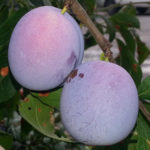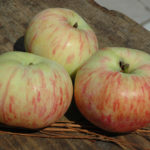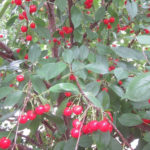Rose Rumba (Rumba)
The queen of flowers, belonging to the floribunda group, is able to make the atmosphere of the garden both cozy and festive. This is because these varieties of roses are incredibly abundant flowering. Particularly noteworthy is the Rumba variety, whose buds have bright, changeable shades.

History of origin
This plant appeared more than half a century ago, in 1958. The variety was bred by Danish breeders from the Poulsen company, founded in the 19th century. Rose got its sonorous name from the name of the Latin American dance, and it is due to the rich tones of the dresses of the dancers performing it. The flower has two alternative names: Cuba Dance and Rosa Meineble.
Description of appearance and features
Rumba is an ornamental flowering shrub with compact dimensions: a height of 40 to 60 cm and a width of about half a meter. Its shoots are straight, rather strong, devoid of sharp thorns; the crown is dense and dense due to the numerous dark green leaves with a pronounced glossy sheen. The flowers that appear on the plant in the warm season are not too large: a maximum of 7 cm in diameter - but very attractive. As the buds open, they repeatedly change their shade. At first, the Rumba flower is creamy yellow, then it turns red or orange at the edges, at the end of the flowering phase it acquires a bright crimson color. It should be noted that each rosebud consists of 34-40 petals. In the phase of complete dissolution, the flowers of the Scandinavian floribunda are double and lush, exuding a pleasant, light aroma. The noble plant blooms profusely throughout the summer season, almost continuously. Each culture can be decorated with 5 to 20 flowers. The open buds of a lovely Danish woman do not crumble even after drying on a bush. By the way, they develop in brushes of 3, 5 or more pieces. The leaves of the rose bush do not fall off even with the arrival of autumn and remain as green and glossy as in summer.

The variety is very resistant to diseases - primarily powdery mildew and black spot. He is not afraid of frost: without prejudice to his own health, he tolerates a drop in air temperature to -23-25 ° C. The magnificent flowers of a bright beauty do not lose their shape and do not rot under the influence of even prolonged rains. During the summer heat, the petals of the wonderful buds do not bake, and their color does not fade in the sun. In general, before you is a hardy rose with excellent immunity.
Growing and care
Culture makes high demands on the degree of illumination of the area in which it grows and develops. The more sunlight Rumba receives during the day, the better. However, it should not be exposed to direct sunlight for a long time in order to avoid the appearance of ugly burns on the flower petals. The best option is to place the perennial where, during the specified time period, it will be dominated by openwork penumbra.
A rose can be planted in a soil poor in nutrients - you will still end up with a profusely flowering bush. But it is still preferable to use fertile, loose, moderately moist soil with deep groundwater for the flower queen from the northern edges. For Rumba, it is important to have good drainage, as the flower does not tolerate stagnant moisture in the soil. The reaction of the substrate should be slightly acidic. An organic fertilizer in the form of humus and peat is certainly introduced into the planting pit 50-60 cm deep.

The main activities for caring for a noble plant: watering, feeding, loosening the soil under the bush, mulching it, weeding, pruning shoots.It is necessary to moisten the soil under Rumba regularly, avoiding the substrate flooding. Water is taken for these purposes, settled, lukewarm. Watering is carried out at intervals of 1-2 times a week, depending on weather conditions. It is recommended to feed the culture in spring, summer and early autumn. Nitrogen fertilizer is used only in the first case; the rest of the time, preference is given to mineral concentrates saturated with potassium, phosphorus and trace elements. Loosening of the soil is carried out several times a month, one day after watering. At the same time, weeds are removed under the rose. Then the area of the trunk circle is covered with mulch.
When pruning in spring, shown during the swelling of the buds, the plant is deprived of dry and frozen shoots. The autumn procedure is to shorten the strong stems of the bush. During the summer, it is imperative to cut off the dried buds from the bush to allow new flowers to appear. At the end of the autumn pruning, the plant is treated with a fungicide solution. By the way, spraying a perennial with preparations that destroy insect pests and fungal diseases is carried out up to three times during the growing season. Cultivating a crop in regions with cold and little snowy winters, it is invariably covered with the onset of frost.
Use cases
Rumba looks great both as a single bush and in groups. The absence of thorn culture on the shoots allows it to be placed in the borders on the sides of garden paths. It can be included in mixed compositions with other annual and perennial plants, other varieties of low-growing roses. The beauty is suitable for placement on flower beds of various shapes and types, including classic round flower beds, mixborders and rabat beds. The tenderness and refinement of the charming shrub will be emphasized by ornamental grasses and fragrant flowering herbs. Conifers will also be good companions for Rumba. For example, a composition consisting of compact rose bushes and evergreen "balls" of boxwood looks very beautiful. A successful combination is a combination of floribunda with plants that have small flowers: verbena, bells, daisies. The buds of this variety stand in water for a long time. They make up delightful flower bouquets and baskets.








